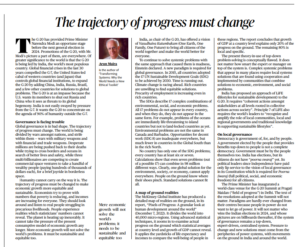Topics:
- G-20 Leadership and the Need for Paradigm Shift in Global Governance
- Prime Minister Visit to Washington: A Historic Opportunity to Strengthen the U.S.-India Trade Relationship
G-20 Leadership and the Need for Paradigm Shift in Global Governance

Context
- India’s leadership of the G-20 is significant as it represents the world’s most populous country.
- However, the G-20 is facing challenges due to the United States’ desire to exclude Russia and China, perceived as threats to its global dominance.
- Global governance is in disarray, with conflicts and economic inequality plaguing the world.
- A paradigm shift in global governance is urgently needed to achieve equitable and sustainable economic growth.
The Urgency for Paradigm Shift in Global Governance
- The current trajectory of progress is leading to a divided world, with wars between nations and internal strife.
- Desperate people seeking better lives are facing dire consequences while crossing borders and oceans.
- Economic growth, as measured by economists, does not necessarily translate into better livelihoods for everyone.
- The planet is also suffering from the consequences of the present consumptive economic model, which cannot be sustained any longer.
India’s Vision and the UN Sustainable Development Goals (SDGs)
- India, as the chair of the G-20, has put forth the vision of Vasudhaiva Kutumbakam (One Earth, One Family, One Future) to foster global unity and improve conditions for all.
- The UN’s Sustainable Development Goals, adopted by all countries in 2015, aim to address various environmental, social, and economic problems by 2030.
- However, rich countries are reluctant to find equitable solutions, and each country faces a unique combination of challenges.
Understanding Ground Realities
- The McKinsey Global Institute’s report “Pixels of Progress” examines human development on the ground in 40,000 micro-regions worldwide.
- It reveals that GDP growth at the national level explains only 20% of progress, while 80% is specific to each locality.
- This challenges the top-down problem-solving approach and emphasizes the need for local solutions and cooperation among stakeholders.
India’s Approach: LiFE and Local Governance
- India proposes the LiFE (lifestyles for sustainable development) approach to the G-20, emphasizing coherent actions rooted in collective efforts across society.
- LiFE also acknowledges the role of local communities, regional governments, and traditional knowledge in supporting sustainable lifestyles.
- For a complete democracy, government must not only be elected by the people but also work for and by the people at the local level.
Conclusion
- The G-20 leadership provides an opportunity for India’s Prime Minister, but it is essential to recognize the need for a paradigm shift in global governance.
- The current approach, centered on power and top-down solutions, is insufficient to address complex systemic issues.
- The focus must be on local systems solutions, cooperation, and community-driven efforts to achieve equitable and sustainable economic growth.
Source: The Hindu
LiFE Approach of India
The LiFE (lifestyles for sustainable development) approach is a vision proposed by India to address the challenges of sustainable development on a global scale.
It seeks to promote coherent actions among various stakeholders at all levels, focusing on collective efforts across society.
The goal is to achieve sustainable lifestyles that are equitable, environmentally friendly, and socially responsible.

Key Principles of the LiFE Approach:
- Coherent Actions: The LiFE approach emphasizes the need for actions that are consistent and integrated across different sectors and levels of society. It recognizes that addressing complex issues such as sustainability requires coordinated efforts from various stakeholders, including governments, businesses, civil society, and individuals.
- 2. Local Communities and Traditional Knowledge: LiFE recognizes the importance of local communities and their traditional knowledge in achieving sustainable development. Local communities often have unique insights and solutions to address environmental, social, and economic challenges specific to their regions.
- Sustainable Lifestyles: The LiFE approach emphasizes the importance of adopting sustainable lifestyles. This involves making conscious choices to reduce consumption, promote renewable resources, minimize waste, and foster responsible behaviors that have a positive impact on the environment and society.
- 4. Equitable Development: LiFE aims to ensure that development is equitable, meaning that it benefits all members of society, especially vulnerable and marginalized groups. It seeks to bridge the gap between the rich and the poor and promote inclusivity in decision-making processes.
- Collective Action: The LiFE approach recognizes that no single entity or country can address global sustainability challenges alone. It calls for collective action among nations, communities, and individuals to collaborate and find solutions together.
Implementation of the LiFE Approach:
The LiFE approach requires the collaboration and commitment of governments, businesses, civil society organizations, and individuals worldwide.
To implement LiFE effectively, the following steps are essential:
- Policy Integration: Governments need to integrate sustainability principles into their policies and strategies. This includes incorporating environmental, social, and economic considerations into decision-making processes.
- Community Engagement: Local communities play a crucial role in implementing sustainable practices. Governments and other stakeholders should involve communities in the planning and execution of development initiatives.
- Promotion of Traditional Knowledge: Traditional knowledge and practices that have proven to be sustainable over time should be respected and integrated into modern development efforts.
- Education and Awareness: Raising awareness about sustainability issues and promoting education on sustainable practices are vital for encouraging individuals to adopt sustainable lifestyles.
- International Cooperation: Achieving global sustainability goals requires cooperation among countries and international organizations. Sharing best practices, technologies, and resources can accelerate progress.
- Monitoring and Evaluation: Regular monitoring and evaluation of sustainability initiatives are crucial to assess their impact and make necessary improvements.
The LiFE approach recognizes that solutions to global sustainability challenges must be context-specific and inclusive.
By focusing on local empowerment, equitable development, and collective efforts, it aims to foster a more sustainable and resilient world for present and future generations.
Prime Minister State Visit to Washington: A Historic Opportunity to Strengthen the U.S.-India Trade Relationship

Context:
- Prime Minister Narendra PM’s state visit to Washington on June 22, 2023, marked a historic event, highlighting the Biden administration’s commitment to cultivating India as a long-term partner in various realms, particularly in the strategic competition with China.
- The visit showcased the extensive areas of cooperation and collaboration between the two countries, ranging from defense trade to emerging technologies like Artificial Intelligence and space exploration.
Trade Relationship: Progress and Potential
- While the U.S.-India trade relationship has been growing and has surpassed $120 billion, it still underperforms relative to its potential.
- To fully realize the potential of this strategic partnership, trade must be given a more central role in the unfolding U.S.-India story.
- India has been proactive in negotiating new trade relationships with important partners worldwide, revisiting long-standing positions, and reducing dependencies on other countries.
Divergent Trade Approaches
- The Biden administration has shifted away from traditional Free Trade Agreements (FTAs) and emphasizes resilient supply chains, reshoring, labor rights, and climate-friendly production.
- However, many skeptics argue that these objectives could be effectively addressed within a revamped FTA agenda.
- The U.S. administration must consider meeting India halfway in its trade policy to ensure that the strategic aspects of the relationship do not outpace the trade side.
India’s Progress in FTAs
- India has recently signed FTAs with the United Arab Emirates and Australia, and it is actively negotiating similar deals with the European Union, the United Kingdom, and Canada.
- While India’s agreements to date do not meet the U.S. gold standard set by the USMCA, the gaps are narrowing.
- India has demonstrated a willingness to gradually open its markets in exchange for concessions through FTAs, as seen in the Economic Cooperation and Trade Agreement with Australia.
Opportunities for a U.S.-India FTA
- Embarking on FTA negotiations between the U.S. and India could lead to extensive agreements in the agricultural sector and facilitate trade in goods, services, and higher levels of investment.
- The PM State visit should serve as a starting point for a more ambitious trade agenda.
- By giving greater attention and stronger mandates to trade negotiators on both sides, the target of $500-$600 billion in bilateral trade by 2030 can be easily surpassed, opening up boundless possibilities for this partnership of the century.
Conclusion
Prime Minister PM’s historic visit to Washington underscored the Biden administration’s commitment to strengthening the U.S.-India partnership in various fields, including trade.
The trade relationship has significant potential, but to fully unlock its benefits, both countries must pursue a more ambitious trade agenda through FTA negotiations.
With the right approach, the target of $500-$600 billion in bilateral trade by 2030 can be achieved, paving the way for an even stronger and prosperous partnership between the two nations.
Source: The Hindu
| A Free Trade Agreement (FTA) between the U.S. and India could bring several potential benefits for both countries: |
- Increased Trade: An FTA would eliminate or reduce tariffs and non-tariff barriers, making it easier and cheaper for goods and services to flow between the two countries. This could lead to a significant increase in bilateral trade volumes, benefiting industries on both sides.
- Economic Growth: Increased trade can spur economic growth in both countries. It can create opportunities for businesses to expand, generate more jobs, and boost overall economic activity.
- Access to New Markets: The FTA could provide businesses in both countries with improved access to each other’s markets. This means that U.S. companies can gain access to India’s large consumer base, while Indian businesses can tap into the vast U.S. market.
- Attracting Foreign Investment: A strong trade relationship may attract foreign investors looking to take advantage of the improved market access and business opportunities in both countries.
- Enhanced Competitiveness: The FTA can foster healthy competition, encouraging companies to become more efficient and innovative to stay competitive in the expanded market.
- Lower Prices for Consumers: Lower tariffs can lead to lower import costs, resulting in more affordable products for consumers in both countries.
- Supply Chain Resilience: The FTA can promote resilient supply chains by reducing dependence on a single market and diversifying sources of goods and services.
- Technology and Knowledge Sharing: With increased collaboration, technology and knowledge transfer between the U.S. and India could accelerate, fostering innovation and growth in key sectors.
- Services and Investment: The FTA could open up new opportunities for services trade and investment, benefiting sectors such as finance, IT, and professional services.
- Strategic Alignment: A strong trade relationship can further strengthen the strategic partnership between the U.S. and India, aligning their interests and promoting stability in the region.
- Geopolitical Influence: A robust economic partnership can enhance both countries’ geopolitical influence, enabling them to address global challenges more effectively.
- Win-Win Outcomes: The FTA negotiations can lead to win-win outcomes by addressing the concerns and priorities of both countries, fostering a balanced and mutually beneficial agreement.
However, it’s essential to acknowledge that negotiating an FTA can be complex and may require addressing various issues, including differing regulatory standards, intellectual property rights, agricultural subsidies, and other sensitive areas.
Nevertheless, if successfully negotiated and implemented, an FTA could bring substantial benefits to both the U.S. and India, fostering a stronger and more comprehensive economic partnership.


